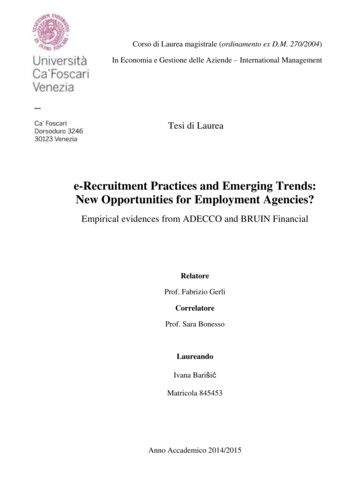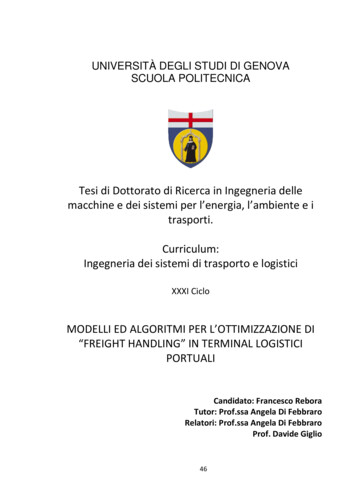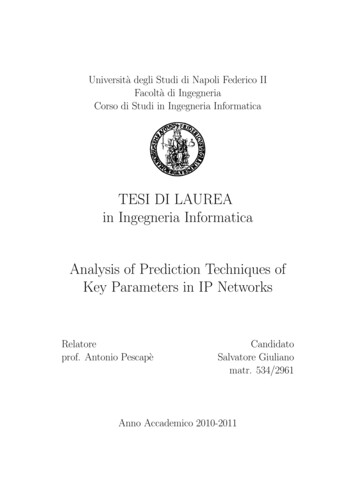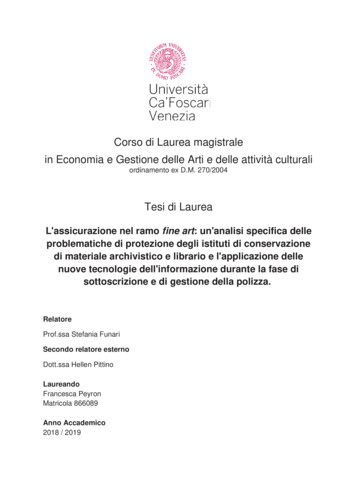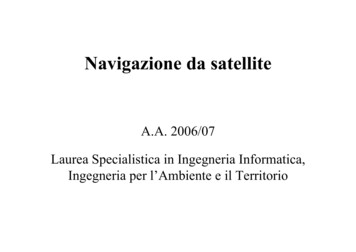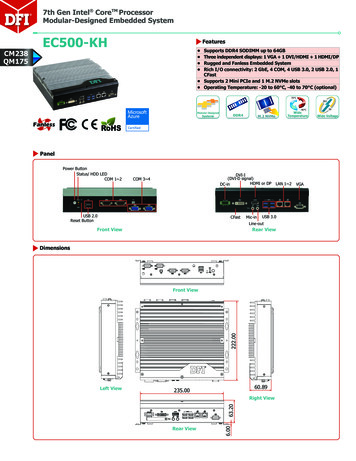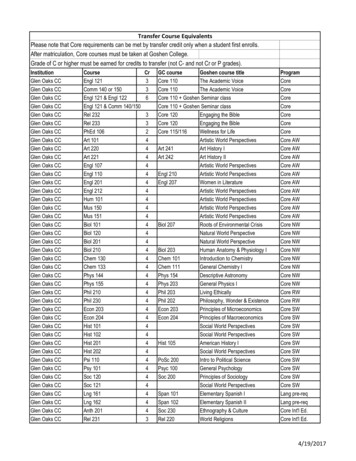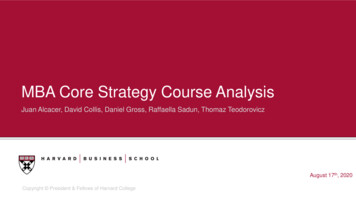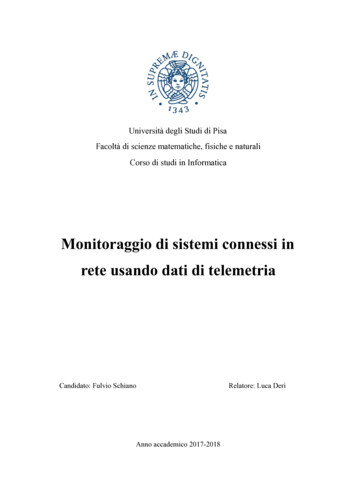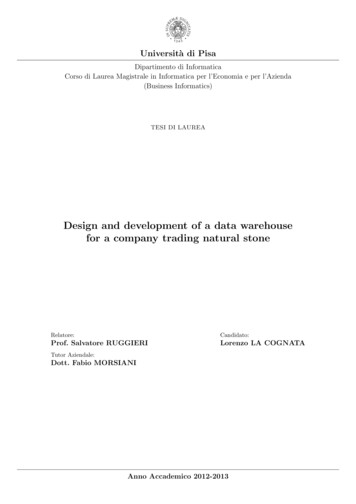
Transcription
Università di PisaDipartimento di InformaticaCorso di Laurea Magistrale in Informatica per l’Economia e per l’Azienda(Business Informatics)TESI DI LAUREADesign and development of a data warehousefor a company trading natural stoneRelatore:Candidato:Prof. Salvatore RUGGIERILorenzo LA COGNATATutor Aziendale:Dott. Fabio MORSIANIAnno Accademico 2012-2013
AbstractThis thesis describes the design and development of a decision support system for R.E.D. Graniti, agroup of companies which extract and market natural stone all over the world. Initially every companyof the group had its own information system, completely independent from the others. When R.E.D.Graniti decided to adopt an Enterprise Resource Planning system to increase uniformity and flexibility,the use of a data warehouse to store and analyze information became a possible powerful source ofcompetitive advantage.After a presentation of the case study and an analysis of the current situation of the natural stonesector, the design and development processes of both the data warehouse and the business intelligencesystem are described in their entirety. The phases covered by this document are the requirementanalysis, the conceptual and logical design of the data warehouse, the extract, transform and loadprocess, the business intelligence metadata construction and finally the development of reports anddashboards.2
ContentsIntroduction1 The1.11.21.31.41.5case studyDeloitte . . . . . . . . . . . . . . . .The natural stone sector . . . . . . .R.E.D. Graniti . . . . . . . . . . . .Business processes analysis . . . . .1.4.1 Sales process . . . . . . . . .1.4.2 Stocks process . . . . . . . .1.4.3 Costs process . . . . . . . . .The initial information system . . .1.5.1 AS/400 . . . . . . . . . . . .1.5.2 Reporting . . . . . . . . . . .1.5.3 Other requirements . . . . . .1.5.4 The final information system5.778111515161717171818192 Analysis requirements specification and initial conceptual design2.1 Introduction to Data Warehousing . . . . . . . . . . . . . . . . . . .2.2 Sales process . . . . . . . . . . . . . . . . . . . . . . . . . . . . . . .2.2.1 Requirements specification . . . . . . . . . . . . . . . . . . .2.2.2 Initial conceptual design of the data mart . . . . . . . . . . .2.3 Stocks process . . . . . . . . . . . . . . . . . . . . . . . . . . . . . . .2.3.1 Requirements specification . . . . . . . . . . . . . . . . . . .2.3.2 Initial conceptual design of the data mart . . . . . . . . . . .2.4 Costs process . . . . . . . . . . . . . . . . . . . . . . . . . . . . . . .2.4.1 Requirements specification . . . . . . . . . . . . . . . . . . .2.4.2 Initial conceptual design of the data mart . . . . . . . . . . .2.5 Summary tables of dimensions and measures . . . . . . . . . . . . .of data. . . . . . . . . . . . . . . . . . . . . . . . . . . . . . . . . . . . . . . . . . . . .marts. . . . . . . . . . . . . . . . . . . . . . . . . . . . . . . . . . . . . . . . . . . . .2020212127272830313133353 Final conceptual design and logical design of the data3.1 The source systems . . . . . . . . . . . . . . . . . . . . .3.1.1 AS/400 . . . . . . . . . . . . . . . . . . . . . . .3.1.2 SAP . . . . . . . . . . . . . . . . . . . . . . . . .3.2 Final conceptual design . . . . . . . . . . . . . . . . . .3.2.1 Sales process . . . . . . . . . . . . . . . . . . . .3.2.2 Stocks process . . . . . . . . . . . . . . . . . . .3.2.3 Costs process . . . . . . . . . . . . . . . . . . . .3.2.4 Summary tables of dimensions and measures . .3.3 Logical design of the data marts . . . . . . . . . . . . .3.4 Logical design of the data warehouse . . . . . . . . . . .marts. . . . . . . . . . . . . . . . . . . . . . . . . . . . . . .37373838404044464950534 Development environment and tools4.1 Comments on the Oracle environment choice . . . . .4.2 Oracle Database Server 11g R2 Standard Edition One4.3 Oracle SQL Developer and Data Modeler . . . . . . .4.4 Oracle Business Intelligence Standard Edition One . .54545556573.
5 Extract, transform and load procedures5.1 The ETL process . . . . . . . . . . . . .5.2 Reasons for not using an ETL tool . . .5.3 Staging Area . . . . . . . . . . . . . . .5.4 Naming convention . . . . . . . . . . . .5.5 Packages structure . . . . . . . . . . . .5.6 Extract phase . . . . . . . . . . . . . . .5.7 Transform phase . . . . . . . . . . . . .5.8 Load phase . . . . . . . . . . . . . . . .5.9 Slowly Changing Dimensions . . . . . .5.10 Data warehouse refresh frequency . . . .58585959596060616365666 Business Intelligence metadata6.1 Physical layer . . . . . . . . .6.2 Business Model layer . . . . .6.3 Presentation layer . . . . . .6.4 Logical and physical queries .67686972747 Reporting7.1 Company Dashboard7.2 Sales Details . . . .7.3 Stocks Details . . . .7.4 Other reports . . . .8283879091.8 Conclusions93Bibliography944
IntroductionPresentation of the problemR.E.D. Graniti group is one of the world leaders in extracting and trading rough granite and marbleblocks worldwide. The company recently considered necessary the increase of organizational flexibilityand information uniformity. This need induced the management to start a development path focusedon the adoption of a new global Enterprise Resource Planning (ERP) system, providing an integratedview of business processes across the different companies all over the world. R.E.D. Graniti appointedthe professional services firm Deloitte for the project and the ERP software chosen was SAP.Alongside this project it was decided to provide the management with an integrated software forenterprise reporting to assist the strategic management of the company business. The software adoptedwas Oracle Business Intelligence and in this document we will discuss the design and implementationof the chosen data warehouse / business intelligence solution.The goal of the business intelligence project is to provide R.E.D. Graniti with a web-based analysisand reporting application for monitoring the business evolution, in particular sales, stocks and costs.Information will be structured in tables, graphs and other forms of data representations to give aclear and immediate view of business performances to the users, who will have the possibility of easilyinteract with reports to perform multidimensional analyses. The application will allow the managementto autonomously produce business reports in a simple and timely manner, export them in differentformats or send them via email.This was very difficult or practically impossible to achieve with the existing information system.While it was possible to examine data and information quite easily, a great deal of effort was necessaryto actually use it. Data manipulation and presentation often required additional work to be manuallydone using spreadsheets, especially for task like grouping, filtering and detecting anomalies and errors.Literature reviewThe data warehouse design approach used and the framework for requirements analysis follow the onespresented by Albano [1] and, to a lesser degree, by Kimball et al. [3] and Oracle [7]. Information aboutthe natural stone sector greatly draw on the XXIV world marble and stones report 2013 by Montani5
[4]. Data about Deloitte and R.E.D. Graniti come from these companies’ internal documentation.Oracle documentation ([6], [9], [8] and [5]) is the reference for software characteristics and technicalparts. Few [2] was of great inspiration for the development of dashboards.Thesis contentsThis thesis describes the design and development of the data warehouse for storing data about R.E.D.Graniti’s sales, stocks and costs and the consequent design and development of business intelligencedashboards and reports, to be used as a decision support system by the company’s management.The first phase of the data warehouse design is the requirements analysis and can be divided in twosub-phases. First requirements are gathered and described in a natural language and then specifiedwith a more technical tabular structure, with a view to modeling the conceptual design of the datawarehouse. The second phase is the initial data mart conceptual design, derived from the analysisusually performed by users and therefore considered an analysis driven design. After that a datadriven design is considered and integrated with the initial conceptual design to produce a final datamart conceptual design. The last phase consists of the data marts logical designs, finally merged in adata warehouse logical design.Development of the data warehouse followed the design, with a particular focus on developmentand testing of extract, transform and load procedures. Concurrently the metadata for the businessintelligence tool are created. After data was loaded into the data warehouse a set of reports anddashboards are designed and developed, to replicate the existing reporting structure in use in R.E.D.Graniti.The case study is presented in Chapter 1, which gives information about R.E.D. Graniti and thenatural stone sector as well as the requirements gathering and the structure of the existing information system. The requirement analysis and the initial conceptual design phases are covered byChapter 2, with separate sections for each of the business processes involved. Chapter 3 is dedicatedto the final conceptual design, the analysis of the source operational systems and the logical designof the data warehouse. Chapter 4 briefly presents the tools used and the Oracle development environment. A detailed description of the data warehouse structure and the PL/SQL procedures used toextract, transform and load data is given in Chapter 5. The business intelligence metadata repositoryconstruction is explained in Chapter 6. Finally Chapter 7 is dedicated to the reporting phase.6
Chapter 1The case studyThis chapter describes the firms involved in the data warehouse project discussed here. The customer’sbusiness in general and its business processes interested by this project are explained in details as theywere discussed in depth during the preliminary meetings with R.E.D. Graniti. Then we introduce thebusiness requirements expressed by the senior management for every process.1.1DeloitteDeloitte is the brand name for the UK private company limited by guarantee called Deloitte ToucheTohmatsu Limited (DTTL). As stated in the Global Impact Report 2013, there are currently morethan 200,000 professionals in 47 independent member firm of the Deloitte network which collaboratein over 150 countries to provide audit, tax, consulting, enterprise risk and financial advisory services.These firms are organized on a country or regional basis and are owned and managed locally, butshare values, methodologies, client service standards and other guidelines.The common organizational structure can be classified in five areas: Audit (financial statement audits, accounting advisory, assurance services) Consulting (human capital, strategy & operations, technology) Enterprise Risk Services (governance, regulatory & risk, security, privacy & resiliency) Financial Advisory (corporate finance advisory, restructuring services, valuation services) Tax & Legal (global business tax, global employer services, legal)Deloitte goals include enabling companies to discover revenue opportunities, navigate complexbusiness landscapes and develop effective solutions to address challenges; the influence on these activities involve leadership, insight, expertise, and deep knowledge of the business domains. Deloitte’s7
approach strongly focuses on integrity and responsible business practices, quality, independence, dataprivacy and security.In Italy Deloitte employs over 3,000 professionals in 18 different cities. The project described herewas completed in the Deloitte eXtended Business Services (Deloitte XBS) office in Parma and involvedone manager and two analysts.1.2The natural stone sectorStones are natural formations of one or more minerals and have been quarried through the centuries.Hundreds of types of stone exist but the Marble Institute of America classifies natural stone intotwo main categories, calcareous stone, composed mainly of calcium carbonate, and siliceous stone,composed mainly of silica or quartz. Marble, travertine and limestone are some of the calcareousstone, granite, slate and sandstone are common siliceous stones. Calcareous stones are more sensitiveand need more care and maintenance, while siliceous stones have a greater resistance and are moredurable.Marble and granite are two of the most famous and most used construction stones. Marble isa metamorphic rock composed of recrystallized limestone. The minerals most commonly composingmarble are calcite and dolomite. Granite is a igneous rock, primarily made of quartz, potassiumfeldspar and sodium feldspar. It is a very hard material and usually has darker colors than marble.Nowadays both granite and marble are extracted using the diamond wire cutting technique. Thistechnique is based on the use of a 5 millimeters diameter steel wire with the help of silica sand andlarge amounts of water as a lubricant. Because of the hardness of diamonds a continuous loop oftensioned steel moving at 20 kilometers per hour is able to cut 20 centimeters of marble per hour.After drilling several holes in the block the insertion of wedges will eventually split the stone alongthe cut, pursuing the strategy to cut large blocks and divide them into smaller pieces.The final output of this process is a block, usually weighting from 10 to 20 metric tons, with averagedimensions of 2.5 meters length, 1.5 meters width and 1 meter height. Blocks this size are then soldto vendors equipped with appropriate sawmills to further cut a block. A block can also be split intoseveral slabs, usually 2 to 4 centimeters thick, possibly polished and treated and then separately soldto customers. Another form to which a block can be reduced, with an added value even higher thanslabs, is the tile, usually best for floors and walls coverings, though the competition of ceramic tiles isvery strong.Three quarters of the total processed material is dedicated to the building sector, especially floorsand paving and special works. Other common uses for natural stone are funeral art, wall cladding andinternal design, such as kitchens and bathrooms.8
New records of production, interchange and consumption of natural stone were achieved in the lastyears, with China, India, Turkey and Brazil leading figures in this development. In the last fifty yearswe observed a sensible reduction of costs, partially due to improvements in technologies and transports,and high investments in research and plants. The flow of quantitative movements increased of morethan five times in the last twenty five years, with a constant increase trend interrupted only in 1998,2008 and 2009. In the same period the growth of the stone sector has been considerably higher thanthat of the global economic system.In 2012 the stone industry marks a continuous productive growth, reaching a total of 123.5 milliontons of raw production and 72.9 million tons of net processed production, 20% more than five yearsago. Marble and other calcareous materials still represent more than half of the production, butgranite and siliceous materials in general had a certain recovery, while slate maintains a secondaryand declining role, as can be seen in Table 1.1.Stone 755.50123.50Percentage58.5%37.0%4.5%100.0%Table 1.1: Natural stone raw production by stone type in 2012Almost two thirds of the world production comes from China, India, Turkey and Brazil, while thefirst 12 countries make 85% of the world production. Italy maintains the lead among the EuropeanUnion, followed by Spain and 00.0%Table 1.2: Natural stone raw production by country in 2012The total world interchange in 2012 was 52 million tons, 4.5% more than in 2011. As Table 1.3shows, raw materials surpassed processed materials, thanks to the good recovery of granite ( 15%9
with respect to the previous year) and because of the increasing demand from China and otherprocessing countries. This is an important strategic tendency, because international transport hasto expect greater loads of materials and because the theoretical increase in expenses is balanced bythe contained costs of concentrating the production activities in third world countries. China, India,Brazil, Turkey and other extra-European countries increased their importance in the interchanges,reaching two thirds of export and half of import volumes, with the European Union losing positions.Product TypeRaw calcareousRaw siliceousSubtotal RawSimple finished productsSpecial finished productsSlateSubtotal 7.7%100.0%Table 1.3: Natural stone import-export by product type in 2012Increase of interchanges means higher requirement in quality, hence the increasing attention toproduction and improvements in technology, such as the automatic resin treatment of slabs. Also constant investments in research, promotion and distribution become necessary, with Europe still leadingfor professional values and creativity. Another sector affected by this tendency is the infrastructuressector, especially since, given the high specific weight of natural stone, transport costs have a greatimpact over the final price of products. Nowadays the use of sea transport is complemented by roadtransport, usually required for journeys from and to harbors, with similar considerations valid forrailway transport, although less used. Another point to be considered is the extraction and processingwaste produced, 180 million tons in 2012, which amounts to 60-70% of the total quarried volume andwhich must be sent to the dump, with non-negligible effects on the environment.Natural stone consumption grew at the same pace of production. The world consumption reached1350 million equivalent square meters1 in 2012, 6.7% more than the previous year. Today the use ofnatural stone is rather universal, as shown by the purchase rate in, for example, Barbados, Macao andMauritius. As for production and exchanges, a strong concentration is registered, with only fifteencountries consuming more than ten million meters and China consuming more than a quarter ofthe total world volume. As for the per capita use of natural stone, some mid-sized countries leadsthe ranking, with Belgium, Switzerland, Taiwan and Saudi Arabia consuming more than one squaremeter per inhabitant.1 Equivalentsquare meters are referred to the conventional slab thickness of 2 centimeters10
CountryChinaIndiaUSABrazilItalySouth KoreaFranceGermanyTaiwanSaudi ArabiaOthersTotalMill. eq. 2%2.1%40.3%100.0%Table 1.4: Natural stone consumption by country in 20121.3R.E.D. GranitiWhen R.E.D. Graniti was founded by Giorgio Conti in 1965 the Apuan stone industry was focusedon the extraction of marble produced in the quarries in Carrara; the company instead dealt in severalvarieties of granite, materials little known at the time, which then quickly became reference points forworld-class architecture.In those years some new technologies were developing, such as diamond tools, and there wereinnovations in polishing and in the granite processing industry in general. This lead to a generalchange in market trends, the morphological and chromatic characteristics of granite determined theaesthetic choices of architects and the preferred materials were produced in a limited number ofcountries.The ideas of Giorgio Conti shaped R.E.D. Graniti as a complex international organization for theselection, storage and transport of marbles and granites from the quarries to the ports and then to thevarious markets. In the mid-seventies the group began actual trading, buying blocks for resale, andthe motto “the material first” was coined. Then the key strategy involved strategic control of the rawmaterial, trading according to exclusive contracts and acquisition of quarries throughout the world;nowadays approximately 80%-90% of all material sold are produced in the company own quarries.The eighties were a decade of significant growth and international expansion for the Apuan stoneindustry, for both production and trade; in the difficult nineties the company’s strategy proved to bedecisive as the sales doubled in just eight years, with an increase much higher than the rest of themarket.11
The continuous search of new quarries and top quality materials and the substantial investmentstoward the strategic control of raw material lead to the expansion of R.E.D. Graniti in Brazil, SouthAfrica, Namibia and Zimbabwe. The group has also an office in Bangalore (India) since 1976, theVermont Quarries Corporation was set up in 1992 in the United States, in order to continue theextraction of the famous white Danby marble quarry, and in 1995 the group acquired Finska, thelargest Scandinavian company working in the production of granite blocks.The company headquarters are in Massa, Italy, where the company has a warehouse which occupiesan area of approximately 60,000 square meters and where 25,000 tons of new materials arrive everymonth from the port in Marina di Carrara, which became the most important hub for this industry.All of this led to the creation of a network of specialized ports in various countries, including Bangalore(India), Vitoria (Brazil), Vigo (Spain), Larvik (Norway) and Durban (South Africa).Today R.E.D. Graniti handles and trades granites and, less frequently, marbles batches in differentshapes and sizes. Different qualities are commercialized, with different colors, patterns, compositionand characteristics. R.E.D. Graniti’s catalog offers more than eight hundred different material qualities,divided by country of origin, the most popular of which are Nero Africa, Giallo Veneziano, Rustenburgand Nero Zimbabwe.Figure 1.1: Some of the material qualities in the company’s catalog12
R.E.D. Graniti S.p.A. declared 68.3 millions euro of revenues for fiscal year 2012, 8% less than theprevious year, with a margin of 785 thousands euro. The companies under the direct control of theparent company work into two divisions, production and sales. These combined departments employa work force of about 1500 people. A small portion of R.E.D. Graniti’s companies also transformsblocks in slabs. Processing materials directly where they are extracted greatly contribute to reducecosts and may be an important strategic change that can be observed in the group’s future.Production companies are located in strategic areas of world stone production such as Brazil,South Africa, Zimbabwe, Namibia, United States, Finland and Norway. Over 200,000 cubic meters inblocks are extracted every year from a total of more than thirty quarries and then sold directly or,more frequently, sent to warehouses in the main sales center and sold by companies of the group’sbusiness division. Important sales centers are located in Europe (Italy, Belgium, Spain, France, Poland,Croatia), Canada, Brazil and China and also handle other varieties of stone materials, even if thecompany’s own materials account for 90% of sales. The main companies of the group are listed in thefollowing table.CountryCompanyDivisionR.E.D. Graniti Brasil (Ltda)SalesPedreiras do Brasil (Ltda)ProductionR.E.D. Graniti Mineração (Ltda)ProductionCanadaR.E.D. Graniti North America IncSalesChinaR.E.D. Graniti Xiamen (Co Ltd)SalesFinlandFinska Stenindustri AbProduction, salesR.E.D. Graniti France SarlSalesRsa Granits SasSalesGermanyR.E.D.Graniti Deutschland GmbhSalesIndiaR.E.D. Graniti Quarries and Blocks IndiaSalesItalyR.E.D. Graniti S.P.A.SalesMadagascarR.E.D. Graniti Madagascar SarlProductionMozambiqueR.E.D. Graniti Mocambique LimitadaSalesR.E.D. Graniti Namibia (Pty Ltd)ProductionArandis Marble (Pty Ltd)ProductionCaprivi Marble & Granite (Pty Ltd)ProductionDamara Granite (Pty Ltd)ProductionAus Marble (Pty Ltd)ProductionBrazilFranceNamibia13
PolandRed Graniti Poland Sp. z o.o.PortugalBeauport Transportes Maritimos (Lda)ServicesR.E.D. Graniti South Africa (Pty Ltd)ProductionRossal No 136 (Pvt Ltd)TransformationKelgran Africa (Pty Ltd)ProductionVerde Bitterfontein (Pty Ltd)ProductionSpainR.E.D. Graniti España SASalesSwitzerlandStonevolution AGSalesVermont Quarries Corp.Production, transform.Colorado Stone Quarries IncProductionVirginia Mist Granite Corp. IncProductionIlford Services (Pvt Ltd)ProductionPanhandle Mine (Pvt Ltd)ProductionRoserocks Mine (Pvt Ltd)ProductionSidingo Mine (Pvt Ltd)ProductionSouthern Granites (Pvt Ltd)TransformationSouth AfricaUnited StatesZimbabweThe next table lists the main stockyards controlled by the group.CountryStockyardBelgiumAntwerpBrazilSuape and VitòriaCanadaQuebec CityChinaXiamenCroatiaRijekaFranceSt. MaloItalyMassa and VeronaPolandStettinoSerbiaSmederevoSpainVigo14
Figure 1.2 shows R.E.D. Graniti’s stockyards in green together with companies, indicated in red.The blue dot represents headquarters in Massa.Figure 1.2: The main companies (in red) and stockyards (in green) of R.E.D. Graniti group1.4Business processes analysisThree different business processes were discussed during the preliminary meetings with the customerand were included in the Data Warehousing project discussed in this document: sales, stocks andcosts. A detailed analysis of each business process is given in the rest of this section.1.4.1Sales processThe most important business process considered involves sales. R.E.D. Graniti primary business consists of extracting marble and granite blocks from quarries, or buying them from other companies,most of the times processing them in some way (e.g. polishing) and then selling them to customerthroughout the world. A sales document is generated where date, materials, customer, storage locationand other information are stored.There are three different situations which usually lead to a sale. The first situation happens whena customer wins an important contract and needs large quantities of one or more specific materials,with a particular attention to quality and uniformity needed. The large number of quarries owned byR.E.D. Graniti make the group based in Massa one of the few in the world to be able to accommodatethese kind of requests. A similar situation arises when a customer needs a small number of blocks andis willing to choose them in a stockyard or directly in a quarry. Assisted by a sales agent the customerhoses down the blocks and tests them for imperfections or defects, then the sale is negotiated andformalized.The last situation involves the group’s sales agents too, since they may propose, on theirown accord, business deals to long-time customers, for example suggesting new materials or specialoffers for materials kept in stock for a long period of time.15
Collection of business requirementsThe following table lists the business requirements expressed by R.E.D. Graniti management. Customer and material dimensions clearly are the most important, while sales amount, costs, margin andvolume are the crucial measures.Sales process1The year to date sales amount, costs, margin and volume, and the corresponding variationsversus last year, by month.2The total sales amount, costs, margin and volume, and the corresponding variations versuslast year, by month, by customer and by material quality.3The top 15 customers by sales amount, or by sales volume, by year and by material quality.4The top 15 material qualities by sales amount, or by sales volume, by year and by customer.5The top 15 material countries by sales amount, or by sales volume, by year.1.4.2Stocks processDue to the international sphere of R.E.D. Graniti business, marble and granite blocks are often movedfrom one storage location to another, in different parts of the world, to better fulfill the customer needsand to reduce the delivery time. Moreover, R.E.D. Graniti does not own any quarry in Italy, unlike inother countries, even if a large part of the customers is based in Italy. This means that the companybased in Massa only buys batches, often from the other companies of the group based in the rest ofthe world, and then resell them to the customers.Another reason for the need of stocking batches, possibly for several months or years, is that, withthe only exception of white, black and, to a lesser degree, yellow, natural stone colors follow the trendof the moment. Some color may go out of fashion and then become fashionable again after a certainperiod of time, maybe in a different
Dipartimento di Informatica Corso di Laurea Magistrale in Informatica per l'Economia e per l'Azienda (Business Informatics) TESI DI LAUREA Design and development of a data warehouse for a company trading natural stone Relatore: Prof. Salvatore RUGGIERI Tutor Aziendale: Dott. Fabio MORSIANI Candidato: Lorenzo LA COGNATA Anno Accademico 2012-2013
